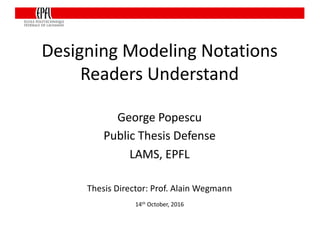
Public presentation
- 5. 1) Improving IT notations 2) Improving one IT notation: SEAM 3) Proposing recommendations for model creation 4) Conclusions and future work 5 Thesis Outline Context Climax Closure Conflict Story
- 8. 8 1) Context Practical and Research Questions How do I, as a SEAM modeler, create a SEAM model, so that readers understand the story that I want to tell?SEAM modeler IT modeler How do I, as a modeler, create a model, so that readers understand the story that I want to tell? Practical question Research question
- 19. 19 2) Conflict Rationale Which dealer? Delaisse AMAG Price Replacement car Duration Question Options Criteria Positive| Neutral | Negative +2 +1 0 -1 -2 Satisficing Accommodation Questions, Options, and Criteria: Elements of Design Space Analysis, Maclean, Young, Bellotti, Moran (1996) The Sciences of the Artificial, Simon (1969) Information, Systems and Information Systems - Making Sense of the Field, Checkland, Holwell (1998) Research Methods Knowledge Base, Trochim (2016)
- 32. 32 Relation with Reality 3) Climax Conceptualization Conceptualization Model ReadersModeler Extension with readers of the conceptualization and modeling framework from The Lightswitch Approach - A Systemic Paradigm for Early IT System Requirements Based on Regulation Principles, Regev (2003)
- 34. 34 Rationale 3) Climax Which one? Option 2 Option 1 Criteria 2 Criteria 1 Criteria 3 Criteria 4 Criteria 5 Question Options Criteria Positive assessment Negative assessment Option 1 Satisficing Accommodation Positive| Neutral | Negative +2 +1 0 -1 -2 Questions, Options, and Criteria: Elements of Design Space Analysis, Maclean, Young, Bellotti, Moran (1996) The Sciences of the Artificial, Simon (1969) Information, Systems and Information Systems - Making Sense of the Field, Checkland, Holwell (1998) Research Methods Knowledge Base, Trochim (2016)
- 36. 36 Model Creation Recommendations 3) Climax 1. Relation with reality ü Use the zone of proximal development between the modeler and the readers’ conceptualizations to show concreteness using photos, icons and terminology that characterize actors 2. Rationale ü Show the main question, the options, the criteria and the assessments of criteria ü Use “satisficing” to model options that do not fully satisfy criteria ü Use “accommodation” to model conflicting interests and consensus 3. Story ü Create model instances for each story phase, e.g., context, conflict, climax and closure ü For each model instance explore the actors’ states to show change
- 37. 37 3) Climax Are these models useful for you when create models with other people? ü Before, during and after workshop - communication of business strategy ü Identity of the notation - important for designer and modelers, not readers ü Implicit elements - useful to learn about readers’ perceptions ü Trade-off between abstraction (modelers) and concreteness (readers) Prof. Alain Wegmann, Professor at EPFL and Consultant Dr. Gil Regev, Senior Researcher at EPFL and Knowledge Manager at ITECOR Mr. Didier Rey Marchetti, Vice-President for Information Systems Delegate at EPFL Mr. Giorgio Anastopoulos, Head of Information Systems Architecture at EPFL Mr. Olivier Hayard, Vice-President Head of Knowledge Management at ITECOR Mr. Gaël de Fourmestraux, Head of Geneva Office at ITECOR Discussion of Recommendations
- 38. 38The models were presented at EPFL’s FORUM IT by Prof Karl Aberer (VPSI) and Professor Alain Wegmann (IC) 3) Climax Context: Situation Climax: Business organization and segments Closure: Organization Conflict: VDI organization1 2 3 4 Impact – EPFL SI
- 45. 45 ü We created improved SEAM models based on interviewing 200 readers ü This research is inter-disciplinary: systems thinking, graphical argumentation, interpretation of reality, learning, and story-telling ü The originality of the research lies in understanding the readers’ conceptualizations in order to create improved models ü Instead of multiple different models of the same situation, we propose one model that illustrates a story 4) Closure Conclusions
- 46. 46 v Modelers can apply our recommendations to v Model other contexts (e.g., organizational strategy, service design, enterprise architecture) v Model other hierarchical levels and refinements with SEAM (e.g., service specification and implementation with business / IT services and processes) v Improve models created with other notations 4) Closure Future Work UML BPMN ArchiMate
- 47. 47 Thank you
